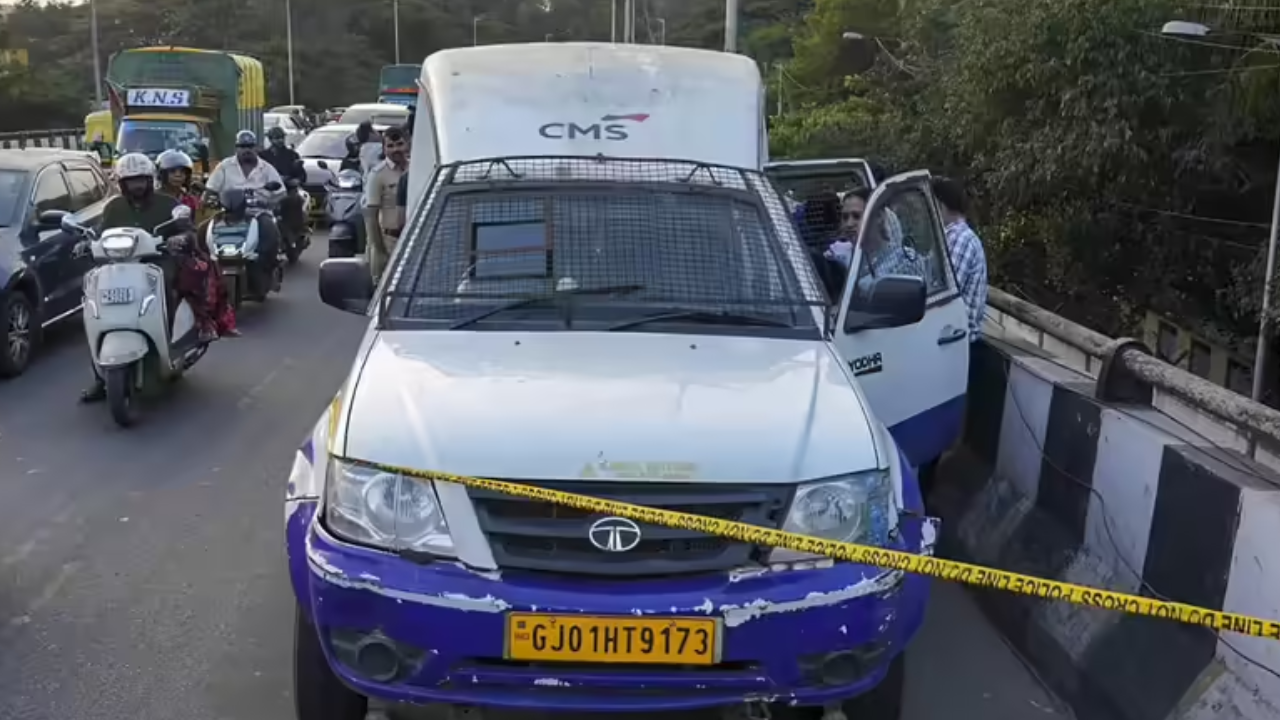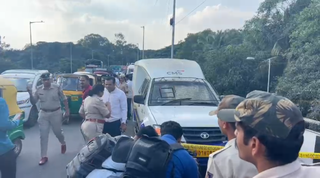The Bengaluru City Police have cracked one of the most sensational cash robberies in recent memory, arresting nine suspects connected to a brazen ATM cash van heist that stunned the city and raised questions about internal collusion, security loopholes, and organised criminal planning. The stolen amount—₹7.1 crore—had triggered statewide alerts, and investigators said the crime displayed precision that suggested a deep understanding of cash transport operations. Police Commissioner M. N. Anucheth confirmed that the entire amount was recovered, calling it a major achievement in the face of growing concerns over high-value crimes targeting financial institutions and transport personnel.
The incident occurred when the cash van assistant entrusted with refilling ATMs allegedly vanished with the money after disconnecting GPS tracking, leaving the driver and security guard in confusion. The suspect reportedly abandoned the vehicle later and fled with the money packed in boxes. What initially looked like a desperate solo theft soon grew into a case involving multiple accomplices, safehouses, and secret handlers. Investigators say the accused had meticulously chosen a time and location where monitoring was weaker, enabling them to move the money undetected for several hours.
According to police, the arrested individuals include key planners, transport helpers, and those responsible for hiding the stolen cash in different areas around Bengaluru and neighbouring districts. The trail of arrests began when police used technical evidence, phone records, and CCTV tracking to identify suspicious movements following the heist. A few of the suspects initially tried to mislead police by pretending they had no connection to the van assistant, yet inconsistencies in their statements and unusual expenditure patterns gave them away. Police insist that the crime cannot be viewed as an impulsive act; it was an organised robbery executed with a surprisingly professional approach.
Investigators revealed that the stolen cash had been shifted several times in smaller packets to avoid raising suspicion. Some of the accused had attempted to store cash in rented rooms; others had divided it among relatives in small bundles. A few had already made purchases that drew police attention, including expensive electronics and sudden loan repayments. Police stated that the recovery was possible only because they acted within hours and sealed possible escape routes around the city. If the suspects had managed to move the money farther outside Karnataka, they believe the recovery would have become far more complicated.
Inside the Crime: How a Trusted Employee Turned into the Key Accused
The primary suspect in the case, a van assistant hired to load ATM currency, reportedly took advantage of his insider position and access to cash boxes. He is believed to have exploited weak monitoring by disconnecting the GPS device, choosing a route without CCTV, and timing the theft between scheduled refilling tasks. Police suggest he may have tested the system previously to understand where supervision was loose. This kind of crime, officers say, is not about brute force but about knowing exactly where vulnerabilities lie in the cash-in-transit network.
Forensic and technical teams traced the movements of the suspect soon after the disappearance by following his mobile phone locations, cross-checking toll gate entries, and scanning nearby petrol station footage. The narrow window in which the van was off-route told police that the act was intentional, not accidental. From that moment, suspicion turned inward. Investigators realized they were not looking at an external attack but at a betrayal within the system—someone with access, knowledge, and emotional motivation strong enough to risk everything.
Police sources suggest that the prime accused may have been facing financial pressures, including debt, personal problems, or an aspiration for fast wealth. However, investigators say the scale of the crime indicates he was not alone and may have been motivated or assisted by others who saw an opportunity to extract large amounts of money with minimal confrontation. The accused had also reportedly scouted places where cash could be hidden. Had it not been for the swift response of the police, these plans might have succeeded in breaking up the money trail permanently.

Cash-van companies are expected to follow strict protocol for locking currency, monitoring vehicle routes, and maintaining transparency in accounting. Yet officers indicated that some of these procedures were not enforced properly that day, especially the tracking system and supervision of staff movements. The incident exposed gaps in private agency operations that handle enormous amounts daily on behalf of banks. Police have recommended that stronger restrictions be imposed on cash handlers, including psychological profiling, background checks, and constant digital tracking to reduce the risk of betrayal from within.
Security Loopholes, Corporate Questions, and the Future of Cash Transport
The heist has sparked debates among banking and security experts about whether India’s rapidly growing digital economy has overshadowed the risks faced by physical cash transport workers. While most financial attention is directed toward online fraud, cash vans still transport crores every day, and crimes targeting them are becoming more sophisticated. Critics argue that many security companies cut corners by appointing poorly trained staff, underpaying employees, and using outdated tracking tools. Such practices make theft tempting and detection harder, especially when internal collusion is involved.
Several questions have emerged over how such massive amounts were accessible to a single employee with minimal supervision. Industry specialists say that when staff members are overworked, poorly paid, or lack accountability mechanisms, trust is often taken for granted rather than safeguarded through checks. Protocols such as dual-key systems, biometric access to cash chests, and sealed GPS devices remain rare. Instead, companies rely on the belief that employees will not misuse access. The Bengaluru heist has exposed the fragility of such assumptions.
Police are expected to submit a report suggesting reforms, including mandating two-person authentication for access to ATM currency boxes, installing tamper-proof GPS systems, and enforcing surprise audits on cash vans. The report may also propose real-time tracking monitored externally by independent agencies rather than by security companies alone. Officers believe that a failure to reform could push criminals to study internal weaknesses further, increasing the frequency of insider crimes rather than violent armed attacks.
The heist has also revealed a troubling pattern: in many high-value cash transport crimes, emotional or personal motives play a strong role. Investigators found that some of the accused in this case appeared desperate for “instant change” in their financial situation. Police believe this emotional factor must be studied seriously. Security companies need to consider psychological screening and counselling for employees handling large sums daily. The stress of debt, family obligations, and economic insecurity can push individuals toward risky decisions, especially when they believe the system around them is exploitable.
Public Shock, Legal Consequences, and the Long Road Ahead
The public reaction to the arrests has been a mix of shock, curiosity, and relief. Bengaluru residents expressed concern over safety of ATM transactions and the integrity of the banking support system that operates behind the scenes. Some citizens questioned whether banks will now raise service charges to cope with increased security costs. Others feared that reduced trust in cash delivery systems might lead to stricter withdrawal regulations. In a financially vibrant city where thousands of transactions rely on ATMs, the incident has triggered wider debates about reliability and reform.
Legal experts say the arrested suspects face charges that may lead to prolonged prison sentences due to the scale of the theft and the involvement of multiple individuals. Under existing laws, conspiracy, theft involving breach of trust, and organized planning carry heavy penalties. Courts are expected to scrutinize not only the heist but also the failures of security agencies. If negligence is proven, companies may face regulatory penalties or be ordered to compensate banks for material or procedural lapses. The legal case will likely become a benchmark for how India deals with insider crimes in cash handling systems.
Banks and financial institutions have begun reassessing their agreements with cash transport companies. Industry leaders are discussing whether direct bank-employed teams should replace outsourced services or whether new regulations must mandate stricter monitoring. Some believe that outsourcing remains practical, but only if companies are forced to invest in technology and training. Others argue that money transport should be treated as a critical national service with government oversight similar to public security agencies.

As the case progresses, the Bengaluru heist stands as a dramatic reminder that financial security does not depend solely on vaults, locks, or guns. It depends on systems that protect against human vulnerabilities—greed, desperation, opportunity, and betrayal. The swift arrests have restored confidence temporarily, but the deeper questions raised by this episode demand answers beyond recovery announcements. Whether banks, governments, and private agencies will use this incident to push lasting reforms remains the final test.
As the case progresses, the Bengaluru heist stands as a dramatic reminder that financial security does not depend solely on vaults, locks, or guns. It depends on systems that protect against human vulnerabilities—greed, desperation, opportunity, and betrayal. The swift arrests have restored confidence temporarily, but the deeper questions raised by this episode demand answers beyond recovery announcements. Whether banks, governments, and private agencies will use this incident to push lasting reforms remains the final test.
Follow: Karnataka Government
Also read: Home | Channel 6 Network – Latest News, Breaking Updates: Politics, Business, Tech & More

